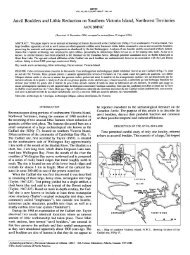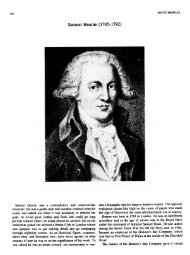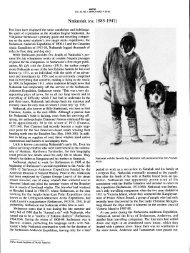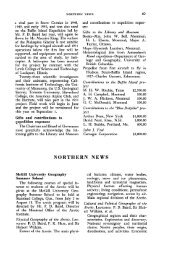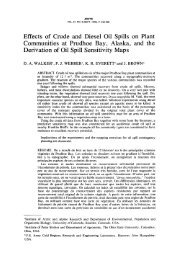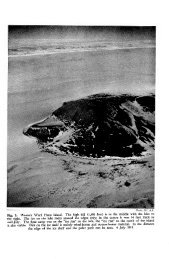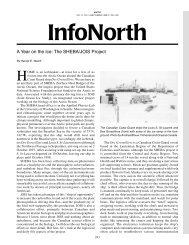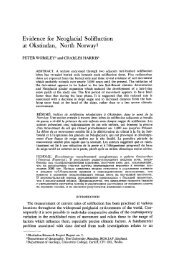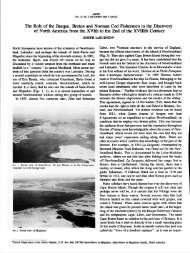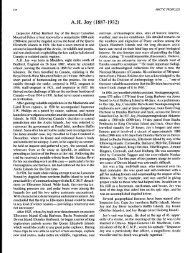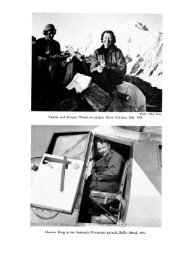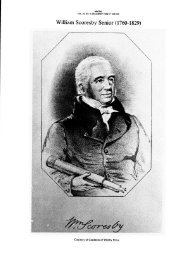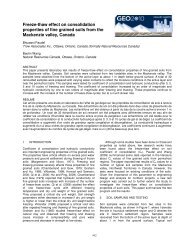To Make These Tribes Understand - AINA Publications Server
To Make These Tribes Understand - AINA Publications Server
To Make These Tribes Understand - AINA Publications Server
Create successful ePaper yourself
Turn your PDF publications into a flip-book with our unique Google optimized e-Paper software.
ARCTIC<br />
VOL. 51, NO. 3 (SEPTEMBER 1998) P. 220– 230<br />
“<strong>To</strong> <strong>Make</strong> <strong>These</strong> <strong>Tribes</strong> <strong>Understand</strong>”: The Trial of Alikomiak and Tatamigana<br />
K.S. COATES 1 and W.R. MORRISON 2<br />
(Received 20 August 1997; accepted in revised form 26 November 1997)<br />
ABSTRACT. Alikomiak and Tatamigana were the first Inuit tried and executed for murder under Canadian law. The case was<br />
the third in a series of killings of outsiders by Inuit in the western Arctic which had begun in 1912; the first two had resulted in<br />
more lenient treatment. The trial of these two men, which took place in the summer of 1923, was in the nature of a show trial,<br />
designed by the federal government to show the Inuit that the authorities would no longer tolerate such acts of violence. It was<br />
also meant to be a demonstration to the world of Canada’s sovereign rights in the Arctic, rights which had an uncertain foundation<br />
in international law. The conviction and execution of Alikomiak and Tatamigana caused controversy at the time; sentiment for<br />
clemency was based on claims (made then and subsequently) that Inuit were simple and primitive, and did not understand the<br />
principle of execution for murder. It is asserted here, however, that the sentence was entirely in keeping with Inuit custom, and<br />
that alternatives to execution suggested by those with better knowledge of the North were in some ways even harsher than capital<br />
punishment. Extracts from the capital case file and the transcripts of the trial make these points clear.<br />
Key words: Alikomiak, Tatamigana, law enforcement, sovereignty, Inuit<br />
RÉSUMÉ. Alikomiak et Tatamigana ont été les premiers Inuit poursuivis en justice et exécutés pour meurtre en vertu de la loi<br />
canadienne. Cette cause était la troisième d’une série de meurtres d’étrangers commis par les Inuit dans l’Arctique occidental, série<br />
qui avait débuté en 1912; les deux premiers meurtres avaient abouti à un traitement moins sévère. Le procès de ces deux hommes,<br />
qui eut lieu durant l’été de 1923, avait quelque chose d’un procès de justification, conçu par le gouvernement fédéral pour montrer<br />
aux Inuit que les autorités ne toléreraient pas plus longtemps de tels actes de violence. Il devait également confirmer au monde<br />
entier la souveraineté du Canada dans l’Arctique, souveraineté qui n’avait pas un fondement bien solide dans le droit international.<br />
À l’époque, l’accusation et l’exécution d’Alikomiak et de Tatamigana suscitèrent une controverse; les partisans de la clémence<br />
affirmèrent (à ce moment-là et par la suite) que les Inuit étaient des êtres simples et primitifs, et qu’ils ne comprenaient pas le<br />
principe d’exécution pour meurtre. On soutient ici, cependant, que la sentence était tout à fait conforme aux coutumes inuit, et<br />
que les solutions autres que l’exécution suggérées par ceux ayant une meilleure connaissance du Nord étaient sous certains aspects<br />
plus dures que la peine de mort. Des extraits d’archives du procès capital et les transcriptions de la cause font la clarté sur ces divers<br />
points.<br />
Mots clés: Alikomiak, Tatamigana, application de la loi, souveraineté, Inuit<br />
Traduit pour la revue Arctic par Nésida Loyer.<br />
In July 1923, two Inuit men, Alikomiak and Tatamigana,<br />
were tried for murder at Herschel Island, a small island just<br />
off the north coast of the Yukon Territory, in the Beaufort<br />
Sea. This uninhabited island is now the Yukon’s first territorial<br />
park, but at the beginning of the century it had a lively<br />
existence as the centre of the whaling industry in the western<br />
Arctic. It had the best natural harbour for hundreds of kilometres<br />
along the Arctic coast, and because of the distance from<br />
home port in San Francisco and other west-coast cities, the<br />
ships came for voyages of two or three years, wintering at<br />
Herschel Island. Around 1895, at the industry’s height, about<br />
1000 people were resident on the island in winter, including<br />
the crews of about a dozen ships, a number of Inuit, and a<br />
missionary and his family (Bockstoce, 1977).<br />
After repeated appeals to the federal government from<br />
W.C. Bompas, Anglican Bishop of the Yukon, who complained<br />
that the Inuit were being debauched by liquor and<br />
sexually exploited by the whalers, a two-man detachment,<br />
consisting of Sergeant F.J. Fitzgerald and a constable of the<br />
Royal North-West Mounted Police, was established on the<br />
island in the summer of 1903. Sergeant Fitzgerald, a veteran<br />
of Yukon service, spent the rest of his career at Herschel<br />
Island; he became famous as leader of the “lost patrol,” in the<br />
winter of 1910 –11, when he and his three companions became<br />
lost and starved to death in an attempt to set a speed record on<br />
the Fort McPherson-Dawson patrol (Morrison, 1985:133).<br />
The whaling industry was on its last legs by 1910, and by<br />
1914 no more whalers came north to hunt the bowhead whale.<br />
1 Faculty of Arts, University of New Brunswick at Saint John, P.O. Box 5050, Saint John, New Brunswick E2L 4L5, Canada;<br />
kcoates@unbsj.ca<br />
2 Department of History, University of Northern British Columbia, 3333 University Way, Prince George, British Columbia V2N 4Z9,<br />
Canada; morrison@unbc.ca<br />
© The Arctic Institute of North America
The Mounted Police detachment on Herschel Island was kept<br />
open, however, since its purpose in the first place was not<br />
really to watch over whalers or protect the Inuit. The post was<br />
there to show the flag—to proclaim the sovereignty of the<br />
Canadian government over the western Arctic. Because significant<br />
areas of the Arctic had been explored by non-<br />
Canadians, particularly Scandinavians, Canadian sovereignty<br />
had to be based on occupation and administration rather than<br />
on claims arising from discovery. It was for this reason that<br />
other detachments were built in the central and eastern Arctic<br />
after World War I, extending the nominal authority of Ottawa<br />
over regions as remote as the Bache Peninsula, in central<br />
eastern Ellesmere Island, which at 79˚N latitude was the most<br />
northerly police post in the history of the police, and the most<br />
northerly post office in the world at that time. Although mail<br />
delivery was only once a year, and there were only two police<br />
and an Inuit family as residents, the existence of the place was<br />
an important manifestation of sovereignty.<br />
A crucial demonstration of sovereignty in the Canadian<br />
North was enforcing the criminal law on the indigenous<br />
people. In the Arctic, the federal government and the police<br />
were at first inclined to take a lenient view of Inuit who broke<br />
the law. The official view was, sensibly, that it was unreasonable<br />
to expect the Inuit to obey the law before they had been<br />
told what it was, and in any case, the police in particular took<br />
a benign view of the Inuit in the early contact period, finding<br />
them cheerful, helpful, and accepting of authority (Morrison,<br />
1985).<br />
Whatever views the Mounted Police held on the Inuit as<br />
individuals, however, their duty lay in enforcing the political<br />
will of the federal government, and it was Ottawa’s wish that<br />
its sovereignty be emphasized in the Arctic through enforcement<br />
of the law. Such enforcement was not an easy task, for<br />
the distances were huge, and the land only newly discovered<br />
by Europeans—as late as 1914, members of the Canadian<br />
Arctic Expedition met groups of Inuit in the central Arctic<br />
who had never (or only very recently) met a non-Inuit<br />
(Condon, 1996:49). A third difficulty was the unusually high<br />
rate of violence and murder among the central Arctic Inuit. As<br />
Sidney Harring (1989) points out, the contact period, roughly<br />
1910 to 1920, saw six Europeans and about forty Inuit<br />
murdered among the Copper Inuit, and all this violence took<br />
place in a community of 700.<br />
The official attitude at first was to deal leniently with these<br />
people, but when the violence continued, the official attitude<br />
hardened. Three cases show this change. In June 1912, two<br />
explorers, H.V. Radford, an American with northern experience,<br />
and George Street, a young man from Ottawa, were<br />
killed by Inuit at the southern end of Bathurst Inlet, apparently<br />
because Radford, who was notoriously bad-tempered,<br />
had threatened and struck an Inuit man who was acting as<br />
their guide. The police sent out an expedition to investigate;<br />
the group ran into difficulties, and it was not until the winter<br />
of 1917–18, when the crime was nearly six years old, that<br />
they obtained solid information about it (Morrison, 1985:<br />
136–137). The government accepted the fact that the Inuit, in<br />
killing these men, were simply following their own law and<br />
INUIT TRIAL AT HERSCHEL ISLAND • 221<br />
tradition, and the expedition to find the men responsible was<br />
more one of exploration than of punishment. They seem<br />
never to have contacted the actual killers, but did reach their<br />
families, and explained to them the error of their ways and<br />
warned them that Canadian law was now to be obeyed.<br />
Late in 1913, two Oblate priests, Fathers Rouvière and<br />
Le Roux, were killed under similar circumstances near<br />
Bloody Falls on the Coppermine River (the site was named<br />
not for this murder, but for an incident 140 years earlier,<br />
when Samuel Hearne’s Indian guides had killed a band of<br />
Inuit there). Le Roux had threatened one of the Inuit<br />
guides, and both men were killed by Sinnisiak and Uluksuk.<br />
In this case, the police located the killers fairly quickly; the<br />
episode became known in 1914, a patrol was sent out in<br />
1915, the killers were contacted and arrested in 1916, and<br />
the men were brought south for trial in 1917. <strong>To</strong> the<br />
astonishment and chagrin of the Mounted Police and the<br />
Oblate order, there was public feeling that priests who<br />
disturbed the primitive innocence of Inuit had got what<br />
they deserved, and Sinnisiak and Uluksuk, on trial in<br />
Edmonton in the summer of 1917 for the murder of Father<br />
Rouvière, were acquitted. Only when they were subsequently<br />
tried in Calgary for the murder of Father Le Roux<br />
was a conviction obtained (Moyles, 1979).<br />
Sinnisiak and Uluksuk were convicted of murder, but in<br />
keeping with the government’s policy of educating the Inuit<br />
to obey the law, they received a light punishment. They were<br />
sentenced to life imprisonment at the police detachment at<br />
Fort Resolution, Northwest Territories, and were not confined,<br />
but were employed in doing odd jobs around the post.<br />
When the Tree River detachment was established in 1919,<br />
they were employed as dog team drivers. They were released<br />
and permitted to return to their band after two years, by which<br />
time they had acquired a certain arrogance and enough<br />
surplus goods from the police to make them rich men in their<br />
communities. As several contemporaries remarked, this episode<br />
showed bad judgement on the part of the authorities,<br />
who left an impression with the Inuit that crime was taken<br />
lightly by the government, or even rewarded (Morrison,<br />
1985:159).<br />
When the third set of murders occurred, therefore, the<br />
authorities were no longer in a forgiving mood, especially<br />
since one of the victims was a Mounted Policeman. The<br />
detachment at Tree River had recently been set up as a<br />
demonstration of sovereignty and the government’s determination<br />
to enforce the law in the Coppermine-Coronation Gulf<br />
region (Fig. 1). The post showed the clear desire to “prevent<br />
murders of whites and to stabilize commercial and government<br />
activity in the Arctic” (Harring, 1989:7), which was<br />
what sovereignty was chiefly concerned with in that era. The<br />
Tree River post was manned by two members of the<br />
RCMP—Constable D.H. Woolams and Corporal W.A.<br />
Doak, who was in command. The three other white men<br />
there were employees of the Hudson’s Bay Company,<br />
which had a post at Tree River.<br />
In December 1921, Corporal Doak, accompanied by Inuit<br />
employees of the police, made a patrol to Kent Peninsula to
222 • K.S. COATES and W.R. MORRISON<br />
FIG. 1. Location of Tree River in the Western Arctic.<br />
investigate a number of killings of Inuit by other Inuit (Fig. 2).<br />
After a short investigation—the community was, as always in<br />
such cases, completely cooperative and forthcoming with<br />
information—he arrested Alikomiak, a young man of sixteen<br />
or nineteen years of age (Fig. 3), and Tatamigana, a man<br />
whose age is not known. Doak returned to Tree River with the<br />
two men and Ikalukpiak, a man he had arrested at Grace Bay<br />
on the return trip for an unrelated killing. Doak and Woolams<br />
did not confine the three men—which would not have been<br />
easy, since the detachment did not possess a lock-up—but put<br />
them to work and gave them complete personal freedom. It<br />
never occurred to the two RCMP officers that the Inuit might<br />
turn on them. The police by this time had developed a<br />
contradictory view of the Inuit: they were considered primitive<br />
and violent, fond of infanticide and other forms of killing,<br />
but once brought under the control of the government, they<br />
were believed to be friendly and docile.<br />
On the night of 1 April 1922, while Constable Woolams<br />
was off on patrol, Alikomiak shot the sleeping Corporal Doak<br />
in the upper leg, and sat for some time watching him die of<br />
blood loss. Early the next morning, he shot Otto Binder, the<br />
Hudson’s Bay Company trader, who had come to call on the<br />
policeman. When Woolams returned from patrol, he seized<br />
the unresisting Alikomiak and tied him up. In the summer he<br />
and Tatamigana, along with some other Inuit, were taken to<br />
Herschel Island for trial.<br />
Doak’s murder, motivated by fear of abuse, echoed the<br />
earlier fate of the two explorers and the two priests. Binder<br />
was killed to keep him from exacting revenge for Doak,<br />
though it was later claimed that a quarrel over a woman was<br />
a contributing factor. Alikomiak’s statement, made on 17<br />
April 1923, a year after the incident, through an Inuit translator<br />
working for the police, has the ring of truth; Sinnisiak<br />
and Uluksuk had said much the same thing several years<br />
earlier:<br />
I was scared of Doak as he sometimes gave me little hard<br />
jobs. One time we went to haul meat and Doak made me<br />
run beside the sled with him. I rode on the sled at times and<br />
so did he. It was deep snow and I could not keep up. Doak<br />
spoke to me but I could not understand him and do not<br />
know whether he was angry with me. I was afraid he might<br />
use the dog whip on me though he never threatened or hit<br />
me with it. Doak gave me boots and lots of things to fix and
FIG. 2. Corporal W.A. Doak on patrol, 1921. National Archives of Canada, RCMP Collection, Access 1996-400, Neg. No. 880.<br />
I did not like it [this was women’s work]. One time he gave<br />
me seal skin long boots to fix the bottoms and I had done<br />
one when he told me that I had not done it right and for me<br />
not to fix the other boot. I was mad and did not feel good<br />
inside. The next day I think I like to kill that man. The<br />
morning after I worked on the boots I went to [the] Police<br />
store house and got Agnavik’s rifle … [Doak] was still<br />
asleep. … I shot him in the left buttock as I did not want<br />
to kill him right away as I wanted him to get mad. I wanted<br />
to wound him as there was [a] revolver beside his bed and<br />
I did not care if he shot me as I did not want to go west to<br />
Herschel Isl. … I did not want to go to a strange country.<br />
… I was afraid Binder would see Doak and want to kill me.<br />
… I shot to kill him. (CDSS, 1923)<br />
If this account is true, and there is no reason to suppose it<br />
is not, Doak showed very poor judgement in his treatment of<br />
Alikomiak, and it is difficult to know why he expressed<br />
impatience with the man, or gave him women’s work to do,<br />
given the fact that the earlier murder cases were well known<br />
by all members of the force—one would have thought that<br />
they would have been particularly careful to avoid the mistakes<br />
of Radford and Street, and the two Oblate fathers.<br />
Admittedly, however, Alikomiak seems to have been especially<br />
sensitive to perceived abuse, since he was never struck<br />
or even shouted at. This, at least, was the official version of<br />
events; a somewhat different story was given by the ethnographer<br />
Knud Rasmussen, who discussed the case a few years<br />
later with some Inuit from the region:<br />
Corporal Doak is described by all as a decent man; but he<br />
was in the habit [of] playing on the feelings of the accused<br />
Alekámiaq by assuming a brutal and terrifying manner,<br />
despite the fact that they could not speak to one another.<br />
According to what the other Eskimos told me, Alekámiaq<br />
INUIT TRIAL AT HERSCHEL ISLAND • 223<br />
by and by got the idea that Doak was going to kill him, so<br />
he decided to forestall him. (Rasmussen, 1932:63)<br />
In July 1923, Alikomiak and Tatamigana were tried at<br />
Herschel Island on a number of charges, along with three<br />
other Inuit charged with lesser offences (Fig. 4). There were<br />
four trials involving the two men; they were all brief by<br />
modern standards, for all were completed in a period of four<br />
days, which included one day wasted on a mistrial. Tatamigana<br />
was tried for killing a man named Hanak and wounding<br />
another man. They were both tried separately for the murder<br />
of another Inuk named Pugnana, and Alikomiak was tried for<br />
the murder of Doak and Binder.<br />
Sidney Harring, in his study of the case, remarks that these<br />
trials were “designed to legitimate some official policy, but<br />
were actually pre-decided” (Harring, 1989:7). In this instance,<br />
the official policy was at least as old as the Mounted<br />
Police themselves. The North-West Mounted Police were<br />
established by the government of John A. Macdonald in 1873<br />
in response to an atrocity that had occurred in what is now<br />
southwestern Saskatchewan, where a group of drunken wolfers<br />
from Montana had murdered more than twenty Indians. What<br />
alarmed Ottawa in this case was not so much the fate of the<br />
Indians, but the notice it gave to the world of the government’s<br />
powerlessness either to prevent such murders or to<br />
punish those who committed them. The North-West Mounted<br />
Police were founded to show the flag, to demonstrate Canada’s<br />
sovereignty over the newly acquired prairies. The<br />
Mounted Police have been described as a semimilitary organization,<br />
but they are more accurately described as being<br />
semipolitical (Morrison, 1985:3– 4). On the prairies they<br />
enforced Macdonald’s “national policy”—they made sure<br />
that settlement was peaceful and orderly, that the Native<br />
people moved to their reserves in a timely fashion, and that<br />
the Canadian Pacific Railway was not delayed by workers’
224 • K.S. COATES and W.R. MORRISON<br />
FIG. 3. Alikomiak, summer 1922. National Archives of Canada, PA-102577.<br />
strikes or Indian protests. Later, they waved the flag for the<br />
first time in the Yukon during the gold rush of 1897–98, and<br />
in the Arctic between 1903 and 1925. It was not until World<br />
War I that their duties were extended to matters such as<br />
national security—investigating putative German spies, and<br />
the like. When Doak and Binder were killed, the police were<br />
the main (indeed, the only) representatives of Canada in the<br />
Arctic, and the attack on them was an attack on Canadian<br />
sovereignty in the region—sovereignty which, because it was<br />
based on some questionable foundations, had to be all the<br />
more carefully defended. It was for these reasons that the trial<br />
of Alikomiak and Tatamigana took on some of the characteristics<br />
of a “show trial.”<br />
Thus the trials that took place at Herschel Island in July<br />
1923 were carefully planned, both for their political impact<br />
and for logistical reasons. The island was chosen because it<br />
was easily accessible and was the only community along the<br />
Arctic coast that had buildings of any considerable size—<br />
these were left over from the whaling days. Judge Lucien<br />
Dubuc of Edmonton, who was also a stipendiary magistrate<br />
of the Northwest Territories, was sent north as judge (Fig. 5).<br />
A student of the territorial judiciary later described Dubuc as<br />
follows:<br />
FIG. 4. Eskimo prisoners at Herschel Island. Alikomiak is fifth from the left and<br />
Tatamigana is barely visible third from the left. National Archives of Canada,<br />
RCMP Collection, Neg. No. 881.<br />
[He was] a compassionate individual who was suited to<br />
the task of introducing the Inuit of the Mackenzie Delta to<br />
only the broad principles of the “white man’s justice.”<br />
There is no evidence, however, that [he] delved extensively<br />
into Inuit customs or their mode of living. Rather he<br />
introduced the formal trappings of the white man’s justice<br />
leaving it to later Magistrates … to try to apply, with<br />
sensitivity, the substance of the white man’s law to the<br />
Inuit. (Price, 1986:317)<br />
Dubuc was accompanied by T.L. Cory, solicitor for the<br />
Northwest Territories Office of the Department of the Interior,<br />
who was appointed counsel for the accused, and I.B.<br />
Howatt, counsel acting for the Crown. The jury was selected<br />
from white residents of the communities along the Mackenzie<br />
River, who travelled with the court party. Preparations were<br />
made for the likelihood of a conviction. The travel season in<br />
that region was short, and it was realized that if the verdict<br />
were guilty, it would be impossible to hang anyone for a year,<br />
until travel made it possible for the hangman to come to<br />
Herschel Island in the summer of 1924. <strong>To</strong> avoid such delay,<br />
which would have weakened the whole point of the proceedings,<br />
the hangman, Special Constable Gill, accompanied the<br />
party, and because of the shortage of suitable timber on<br />
Herschel Island, a portable gallows was taken along as well.<br />
Private correspondence from government officials and<br />
others before the trial began made it appear that example and<br />
deterrence were the main goals. Cortland Starnes, Assistant<br />
Commissioner of the RCMP, commented that the previous<br />
policy of leniency towards Inuit who killed outsiders had not<br />
worked, and that there was a danger that these people would<br />
conclude “that crime is a thing to be rewarded by the White<br />
man.” He recommended that steps be taken to “impress upon<br />
the Eskimo that such disregard for human life will not be<br />
tolerated and those found guilty of committing murder will be<br />
adequately punished” (Starnes, 1922).<br />
Perhaps the most remarkable comment made before the<br />
trial came from the lawyer appointed to defend the accused.<br />
T.L. Cory, as solicitor for the Northwest Territories Branch,<br />
was a government employee. His employer, the Department<br />
of the Interior, was the arm of government most concerned<br />
with the establishment of peace, order, and good government<br />
in northern Canada. Moreover, W.W. Cory, the Deputy
FIG. 5. Judge Lucien Dubuc, who presided at the trial of Alikomiak and<br />
Tatamigana. National Archives of Canada, PA-019353.<br />
Minister of the Interior, was his father. Presumably T.L. Cory<br />
was appointed for the defence partly because he drew a<br />
government salary and would not have to be paid extra for the<br />
task—Ottawa was very conscious of such costs in those<br />
distant days. Doubtless the trip to such an exotic locale<br />
appealed to him. But one would not have to be a conspiracy<br />
INUIT TRIAL AT HERSCHEL ISLAND • 225<br />
theorist to suppose that the main reason he was appointed was<br />
that it was expected that he would not overexert his talents on<br />
behalf of the accused, nor was he likely to make emotional<br />
post-trial statements in the press.<br />
In September 1922, before his appointment as defence<br />
counsel, Cory wrote a memorandum to his immediate superior,<br />
O.S. Finnie, Director of the Northwest Territories Branch<br />
of the Department of the Interior, echoing Starnes’s opinion<br />
that harsh public measures were required:<br />
The numerous murders committed by Eskimos in the last<br />
year or so, clearly indicate that kindness and clemency<br />
have not had the desired effect upon the native population<br />
and I am strongly of the opinion that a court ought to be<br />
sent into the N.W.T. in 1923 to try those accused of<br />
murder. The cases should be tried midst the accused’s<br />
local surroundings where the Native will feel the influence<br />
of the law, and those found guilty should receive the<br />
utmost penalty … As kindness has failed in the past I<br />
strongly recommend that the law should take its course<br />
and those Eskimos found guilty of murder should be<br />
hanged in a place where the natives will see and recognize<br />
the outcome of taking another’s life. (Cory, 1922)<br />
A few months later, he was appointed to defend these same<br />
men.<br />
Of the transcripts of trials that took place at Herschel<br />
Island in the summer of 1923, only the three capital cases<br />
have been found in the records: R. v. Alikomiak for the<br />
murder of Pugnana, R. v. Tatamigana for the murder of<br />
Pugnana, and R. v. Alikomiak for the murder of Otto Binder<br />
and Corporal Doak. The first two were short, almost perfunctory<br />
affairs. The facts were not in question, since the Inuit<br />
involved had made full confessions to the police soon after<br />
their arrest. Tatamigana was called as a witness to testify<br />
against Alikomiak, and vice versa. The proceedings were<br />
conducted in English, with the police translator interpreting<br />
for the benefit of the accused, and the result was never in<br />
doubt. The transcripts are fifteen and nineteen double-spaced,<br />
legal sized pages, which include charge, evidence, summation,<br />
and verdict. Both took place on the same day, 17 July,<br />
and each trial must have taken only a couple of hours. In one<br />
case the jury deliberated for nineteen minutes, and in the other<br />
case they took eight minutes to arrive at a verdict of guilty. No<br />
witnesses were called for the defence in either case, and the<br />
judge delivered a summation, which must have taken only a<br />
few minutes, to the effect that the facts were clear enough, but<br />
that he did not wish to influence the verdict.<br />
The third murder trial, which took place the next day, was<br />
a different affair. Its transcript was longer, 51 pages, since<br />
Alikomiak was on trial for two killings (Fig. 6). As well, the<br />
judge addressed the jury at much greater length. As with the<br />
first two trials, the accused had made a full confession, no<br />
witnesses were called for the defence, and Cory’s crossexamination<br />
was confined to minor points of fact. In his<br />
summation, he apparently made an impassioned plea for the<br />
accused on the grounds of his ignorance of the law, but this
226 • K.S. COATES and W.R. MORRISON<br />
was not recorded in the transcript, which says only “Mr. Cory<br />
replied on behalf of the Defence.” Cory’s defence has been<br />
harshly criticized by one student of the case, who characterizes<br />
it as “neither incisive nor crisp … aimless. Seemingly<br />
seduced by tangential issues, he examined on matters wholly<br />
irrelevant to the central issues of the case. <strong>To</strong> blatant hearsay<br />
he made no objection” (Price, 1991:226). It seems possible<br />
that, had Cory pursued a number of technical and jurisdictional<br />
matters, the verdict might have been different.<br />
Judge Dubuc admitted as much, commenting later that “in<br />
the hands of a less scrupulous lawyer there would probably<br />
have been an acquittal … and this expensive expedition<br />
would have ended in a gigantic fiasco and miscarriage of<br />
justice” (Price, 1991: 220). Cory, who was not in any case<br />
a criminal lawyer, knew his role, however, and no embarrassing<br />
acquittal occurred.<br />
Judge Dubuc’s address to the jury was fully recorded, and<br />
is highly interesting as evidence of the official attitude towards<br />
the case and towards the Inuit. It is clear from the record<br />
that there was no thought at all of incorporating Inuit ideas of<br />
justice into the trial, or of tempering the judicial process to<br />
northern conditions, as later judges, notably J.H. Sissons and<br />
W.G. Morrow, began to do after World War II (Eber, 1997).<br />
He began with a nod towards British justice, “which has been<br />
the envy of all other Nations, and which has conquered the<br />
admiration and respect of all the individuals and even the<br />
nations which have sought its protection.” He then<br />
complimented the jury:<br />
Gentlemen of the North, you who live on the edge of<br />
civilization, as it were, in that “No-man’s land” between<br />
the civilized and uncivilized portion of our great country,<br />
who endure all the hardships incident to this rugged<br />
country of ice and snow, with its every day privations;<br />
blazing the trail that the path may be clear and easier for<br />
those to follow. You have been selected … to listen and to<br />
weigh the evidence presented to you because you have a<br />
personal knowledge of the ways and customs of these<br />
nomads [nomadic?] and unruled Eskimo who travel<br />
these shores … You will notice that the panel chosen to<br />
help at these trials is composed of Traders, Trappers,<br />
Prospectors, Captains of Ships and moreover, some of<br />
them are married to Natives, so that it represents every<br />
phase of northern life, and thoroughly represents the<br />
sentiment of the North; that is why I expect from you a true<br />
verdict in true conformity with the evidence, having at the<br />
same time regard also to a justice which will be understood<br />
by these Eskimo. (CDSS, 1923)<br />
He then got to the real point of his speech:<br />
I am further satisfied that you shall not fail to bring a<br />
correct verdict because you have not forgotten I am sure<br />
those undying principles of British fair play which go with<br />
British justice, for although you may feel that you should<br />
have some consideration for the simple mentality of these<br />
primitive people, yet you also feel that you owe a duty to<br />
FIG. 6. Alikomiak. The original caption reads “This Eskimo was responsible<br />
[for killing] Doak & Otto Bender [sic] Hudson’s Bay Factor.” National<br />
Archives of Canada, RCMP Collection, Neg. No. 881.<br />
your country, who extends to them its generous protection<br />
in every way.<br />
One of the victims, Otto Binder, was a northern man<br />
like yourselves, a member of the oldest trading company<br />
in the North, a Company who has been the pioneer of<br />
civilization in Western and Northern Canada, and whose<br />
kindness and benevolency to the natives in the past, and<br />
even now through its self sacrificing Agents at different<br />
posts, is, in many cases, not sufficiently appreciated.<br />
The other victim, Corporal Doak, was an Officer of the<br />
Royal Canadian Mounted Police in the north, one of those<br />
lonely and fearless sentinels for Law and Order, posted<br />
somewhere on some barren and desolate point in the Polar<br />
Sea. A man whose duty was to prevent if possible, and if<br />
not, to detect and help in punishment of crime. This adds<br />
interest to this case and to the charge against the accused<br />
because we are all concerned in the protection of those<br />
silent men who traverse and patrol these lands of ice and
snow, and who are always on guard for us; we are<br />
interested in the safeguarding of those whose duty it is to<br />
protect us. Corporal Doak[,] one of the ablest and kindest<br />
members of that distinguished Force[,] … was brutally<br />
murdered, defenceless in his sleep, in one of the most<br />
coldblooded manners known in the annals of the Force, a<br />
victim of his kindness to the accused. While he had the<br />
accused in his custody he was protecting him at the same<br />
time from his own people, who wanted retribution for an<br />
alleged previous murder.<br />
The blood of Corporal Doak does not cry out for<br />
vengeance, and it is possible, when he turned on his death<br />
bed to look in the eye of the aggressor, that his last<br />
thought, in that moment’s awakening before his eternal<br />
sleep, may have been one of Christian forgiveness; let us<br />
hope so. But at this trial the personality of the individual<br />
must be laid aside. It is your duty as Jurymen who have<br />
taken the oath as such to decide according to the evidence,<br />
and make these tribes understand that the stern but at the<br />
same time just hand of British justice extends also to these<br />
northern shores. We want it plainly understood in the<br />
minds of these people that one of our most important laws<br />
is for the protection of human life which flows from the<br />
Divine command “Thou shalt not kill.”<br />
It is all very well to plead for mercy and play on your<br />
sympathy for these uncultured tribes, but murder amongst<br />
all people…has always been a crime of the most hateful<br />
and punishable character. When such eloquent and<br />
sentimental appeals are made to you, do not forget the<br />
innocent victims Otto Binder and Corporal Doak, beloved<br />
by all those who have known them, who have been<br />
cowardly murdered. Remember that after all it is hands<br />
drenched with the blood of his own tribe and of his two<br />
white benefactors which are lifted to you to plead for<br />
mercy. Remember that this is not a court of mercy but is<br />
a Court of Justice, and mercy should be given only by a<br />
Higher Tribunal after proper representation is made to it,<br />
I mean the Governor General as representing the King.<br />
I will now leave this view of the case which is<br />
painful to us all, but I could not let it pass in silence<br />
after the eloquent, emotional, and so sentimental appeal<br />
of the Counsel for the Defence on behalf of the accused.<br />
I am myself a man of the West, I have travelled long<br />
enough among the frontiersmen and pioneers of the<br />
North to know that under their rugged and stern<br />
appearance, there beats a heart as tender as it is human,<br />
a heart that warms up quickly to all human sufferings<br />
and weaknesses. I know how a sympathy and forgiveness<br />
that knows no bounds flows generously from those who<br />
themselves have endured so much of life’s hardships<br />
and privations. I have learnt to appreciate how far a<br />
northern man will go to help a neighbour who is in<br />
trouble, but today, Gentlemen, the country is making<br />
an appeal to your honour as good Canadians to do your<br />
duty fearlessly, and you should not therefore let yourself<br />
be unduly swayed by sentiment of pity and mercy<br />
alone.<br />
INUIT TRIAL AT HERSCHEL ISLAND • 227<br />
I speak now with a knowledge of what I say and for a<br />
special purpose, because it has come to my ears that some<br />
members of the Jury had already expressed before the trial<br />
ideas of mercy and acquittal unmindful no doubt of the<br />
consequences. Our Government has not undertaken this<br />
expensive Judicial Expedition to have exhibited here a<br />
mockery and travesty of Justice before these primitive<br />
people. You have a duty to perform as Jurymen, a duty to<br />
your Country and to our Laws, and a duty to yourselves.<br />
We are leaving this Island very shortly after these Trials<br />
and the result of your verdict shall fall on you who are to<br />
remain here, and it is you who shall have to bear the<br />
consequences (CDSS, 1923)<br />
A student of the case commented about this remarkably<br />
histrionic and one-sided speech, that it was “graphic, admittedly;<br />
stirring, undoubtedly; in the nature of an unbiased and<br />
unemotional jury address, assuredly not!” (Price, 1986:317).<br />
<strong>To</strong>day it would surely lead to a successful appeal for a new<br />
trial. Dubuc went on to explain the law in the case, praise the<br />
counsel for the Crown and for the defence, and exhort the jury<br />
once again to do their duty. The jury retired, deliberated for<br />
eighteen minutes, and returned a verdict of guilty.<br />
Although Judge Dubuc expected to leave the next day, he<br />
was delayed several weeks awaiting the steamer that would<br />
take him back up the Mackenzie River. On 11 August, the day<br />
before his departure, he sentenced both men to be hanged on<br />
7 December. Back in Edmonton, on 22 September 1923, he<br />
wrote a report on the trials to the Secretary of State in Ottawa,<br />
in which he recommended strongly that no clemency be<br />
shown to either of the convicted men, while at the same time<br />
suggesting alternatives to traditional punishment:<br />
Imprisonment in the North for the Eskimo is nearly<br />
impossible and is not taken seriously by them … For<br />
the Eskimo, every day of his life is a fight and struggle<br />
for food and existence under the most rigorous<br />
climatic conditions; so that, being fed and housed<br />
with the Police … is not only a reward, but an honour<br />
… Close confinement in our Penitentiaries outside<br />
would mean to them sure death within a very short time.<br />
It is my opinion that the Criminal Code [should] be<br />
amended if possible, empowering the Judge to sentence a<br />
criminal Eskimo to imprisonment on bread and water and<br />
inflict the lash; that this form of punishment be continued<br />
in effect for a few years until these people are more<br />
civilized. <strong>To</strong> be whipped is to be treated like a dog and is<br />
to them the greatest humiliation; such a sentence would be<br />
real punishment and one they could understand. If this<br />
cannot be done, and long terms of useless goal [sic, gaol]<br />
have to continue to be administered, power should be<br />
given the Judge to see to it that the family of the men<br />
sentenced does not suffer (for they are nomads, have no<br />
chiefs, and do not live in groups and to leave their families<br />
unprovided for is to sentence them to perish. …)<br />
With my experience and the study of the character of<br />
the Eskimo, and having in view the protection of the white
228 • K.S. COATES and W.R. MORRISON<br />
men visiting the North country … and lastly the brutal and<br />
cowardly murder of Otto Binder and Corporal Doak, I feel<br />
it my duty, although very painful to me, to recommend<br />
most respectfully, but most earnestly, that the Law follow<br />
its course. (CDSS, 1923)<br />
At the time, no one remarked on the significance of the fact<br />
that only Alikomiak had been condemned for killing whites;<br />
Tatamigana was sentenced for killing one of his own people.<br />
This might have been taken as an example of even-handedness<br />
on the part of the government, and is perhaps the reason,<br />
though the records are silent on the point, why Tatamigana,<br />
who had not even fired the shot that killed Pugnana, though<br />
he had plotted it with Alikomiak, was also sentenced to hang.<br />
Perhaps the government wanted to make an example of him<br />
to demonstrate that the law would protect the Inuit in the same<br />
fashion as whites.<br />
The cases of Alikomiak and Tatamigana attracted a great<br />
deal of attention in the newspapers and amongst the public.<br />
The government received petitions and letters recommending<br />
clemency, both from members of the general public and<br />
from people with northern experience. The typical argument<br />
rested on the idea that the Inuit were primitive, childlike, and<br />
ignorant of the law; an undated letter from E. Maitland of<br />
Plummer, Ontario, expressed the idea eloquently:<br />
Although a woman, I am not one who favours the abolition<br />
of the death penalty … but it seems not unreasonable to<br />
sympathize with the ignorant, primitive people, standing<br />
confused and bewildered in one of our law courts, and so<br />
simple-minded and remote from the subtleties of<br />
“civilized” law proceedings that they told a straightforward<br />
tale, which practically convicted themselves.<br />
(CDSS, 1923)<br />
Wilfred Grenfell, the medical missionary, commented<br />
publicly on the case, stating that “to hang an Eskimo for<br />
murder is the same as hanging a little child … The Eskimos<br />
are an extraordinarily intelligent people … but they are totally<br />
ignorant of law and the consequences of its violation. Ethically,<br />
the Eskimo is just like a child of seven years. You would<br />
not hang a child of seven years, would you?” (Grenfell, 1923).<br />
One wonders how much he had learned about Inuit culture<br />
during his thirty years of service on the Labrador coast.<br />
Some Northerners also commented on the case, notably<br />
J.R. Lucas, Anglican Bishop of Mackenzie River, within<br />
whose diocese the murders had occurred and who had witnessed<br />
the trials, and I.O. Stringer, Bishop of the Yukon. Both<br />
made the argument that the condemned men should not be<br />
executed for breaking laws that they knew nothing about, and<br />
should instead suffer life imprisonment, but the government<br />
had heard these arguments in previous cases and was not<br />
prepared to yield to them again (CDSS, 1923). Bishop Lucas<br />
also made the point in a letter of 17 September 1922 to R.<br />
Dandurand, Acting Minister of Justice, that “it will not<br />
enhance the reputation of the White man among them, if they<br />
think that it was fear of meeting a similar fate that led them to<br />
take their countrymen away where it would be safe to kill<br />
them…the execution of these two men will jeopardize the<br />
lives of White men who may be living amongst the tribes of<br />
Eskimos whence these murderers came” (CDSS, 1923).<br />
W.D. Reeve, Bishop of <strong>To</strong>ronto, suggested corporal punishment<br />
as an alternative to death: “Imprisonment or banishment<br />
would not be adequate, but what about flogging? I am<br />
inclined to think that the application of the lash would have<br />
a greater moral and deterrent effect than anything else”<br />
(CDSS, 1923).<br />
It was suggested in the press and elsewhere that Alikomiak<br />
was only 16 years old, but the police secured a statement from<br />
a trader who had known the man for six years and swore that<br />
he was at least an adolescent when he first met him. It was also<br />
suggested that Otto Binder had started the sequence of events<br />
by stealing the wife of a local Inuit, a rumour that sparked a<br />
petition from the Hamilton Ontario Local Council of Women,<br />
who sympathized with men who had “followed their own<br />
natural light in regard to right, in avenging this transgression<br />
against home and wifehood” (CDSS, 1923). This rumour was<br />
denied by the police, who presented statements from witnesses<br />
to disprove it; and even if true, it would have had little<br />
bearing on the murder of Doak.<br />
Although the bishops and a number of others protested the<br />
sentences, the newspapers generally supported them<br />
(Morrison, 1985:160), and the government—not surprisingly<br />
given the sequence of events—refused to commute<br />
them. Accordingly, a Mounted Police patrol was sent from<br />
the northern Yukon to Herschel Island in the late fall of 1923<br />
with the news that there was to be no mercy, and the two men<br />
went stoically to the gallows on 1 February 1924. Knud<br />
Rasmussen described their last hours:<br />
one evening late in winter, while following their customary<br />
occupation of making salmon nets, they were informed<br />
that they were to be hanged next morning at three o’clock.<br />
Young Alekámiaq received the news with a smile. The<br />
other man, who was somewhat older, felt as if he was<br />
choking and asked for a glass of water; having taken a<br />
drink he too was ready to meet his fate. Just before they<br />
were to be executed they gave the wife of the police<br />
sergeant some small souvenirs carved in walrus ivory, as<br />
a sign that they bore no malice towards the police. They<br />
ascended the scaffold with great calmness and met death<br />
without fear. (Rasmussen, 1932:64)<br />
What conclusions can be drawn from this episode? The<br />
most important and the most obvious, as has been noted by<br />
other commentators (Harring, 1989; Price, 1991), is that<br />
these were clearly show trials, carefully staged for public<br />
effect. Everything about them, from the location to the<br />
sentencing, was designed to send a message that Canada’s<br />
sovereignty over the region was to be enforced. The question<br />
arises, however, for whom the show was put on. <strong>To</strong> whom<br />
was the message directed? The immediate answer would<br />
seem to be to the Inuit, but for a number of reasons this seems<br />
not to be the whole truth. It is just as likely that the
government’s purpose was to demonstrate to the Canadian<br />
public as a whole, as well as to the world, that the old laissezfaire<br />
attitude towards the North had ended and a new activist<br />
era had begun. It is significant that the trials of Alikomiak and<br />
Tatamigana took place at a time when the government was<br />
busily involved in establishing police posts in a number of<br />
remote spots in the Arctic for the purpose of demonstrating<br />
sovereignty, the basis for which under international law was<br />
more than a little questionable. In some places, such as the<br />
Bache Peninsula on Ellesmere Island, there were no inhabitants<br />
at all, so the demonstrations of sovereignty were confined<br />
to operating a pro forma post office, but in the western<br />
Arctic, the case under discussion here provided the opportunity<br />
for an actual criminal trial, one of the best demonstrations<br />
of sovereignty possible.<br />
The assertion that these trials were show trials for southerners<br />
as much as or more than for the Inuit is further<br />
reinforced by the sentences themselves. Many people commented<br />
at the time and have commented since that it was<br />
wrong to hang men when they were in ignorance of Canadian<br />
law; this was the main point made by those who signed<br />
petitions asking for clemency—the convicted men were<br />
“simple,” “primitive,” “ignorant of the law,” and so forth. But<br />
after all, the punishment for killing among the Inuit was the<br />
same as it was in the Canadian criminal code. Inuit who killed<br />
their own people could expect to be killed in return, and<br />
murder and retribution were extremely common among the<br />
Copper Inuit of that era; Rasmussen described a “small snowhut<br />
camp of fifteen families … [containing] not a single<br />
grown man who had not been involved in a killing in some<br />
way or other” (Rasmussen, 1932:17). It was the proceedings,<br />
not the sentence, that were alien to the Inuit.<br />
In this regard, it is surely significant that several observers<br />
who knew the Inuit well had suggested that corporal punishment<br />
would be a more appropriate punishment than would<br />
hanging. Judge Dubuc and three bishops of the Anglican<br />
church, one of whom was present at the trial, recommended<br />
punishments—life imprisonment, bread and water, flogging—<br />
which would have seemed more terrible to the Inuit than<br />
hanging. Though Dubuc was admittedly no expert, at least<br />
two of these men knew the North very well at first hand, better<br />
apparently than the government did. At first glance their<br />
advice seems merciful. But these punishments were, as these<br />
men themselves said, a far more severe penalty from the Inuit<br />
point of view than was hanging. Execution was the usual Inuit<br />
way of punishing murder, but corporal punishment was not<br />
only unusual, but as all three murder cases had demonstrated,<br />
something that the Inuit feared and resented. Being taken<br />
from their country to an unknown place and never returned<br />
was even worse; indeed, one reason Alikomiak gave for<br />
shooting Doak was that he did not want to be taken to<br />
Herschel Island for trial. The bishops and the judge were thus<br />
not simply squeamish liberals balking at a couple of salutary<br />
executions, but were, on the contrary, suggesting culturally<br />
devastating punishments which might well have had the<br />
deterrent effect the government claimed it wanted. Knowing<br />
what we do about the Inuit attitude towards physical<br />
INUIT TRIAL AT HERSCHEL ISLAND • 229<br />
punishment and exile makes the bishops seem much less<br />
merciful, though much more aware of Inuit culture, than<br />
were outsiders.<br />
Why then did the government not accept the advice of the<br />
judge and the bishops and modify the punishment to something<br />
far more humiliating and perhaps more effective than<br />
hanging? Part of the reason must be that the trials were for<br />
southern consumption, and in the south a flogging followed<br />
by imprisonment at hard labour would have been seen as<br />
insufficiently harsh. The federal government had been sensitive<br />
ever since the Alaska boundary dispute of 1903 to the<br />
charge of being weak in upholding Canada’s authority in the<br />
North. By hanging Alikomiak and Tatamigana, it showed<br />
Canadians that it would brook no further violence from Inuit,<br />
and it demonstrated to foreigners that the government intended<br />
to be a strong force in the region.<br />
This case may be seen also as a precursor to the current<br />
practice of imposing culturally relevant and appropriate sentences<br />
in some criminal cases involving First Nations people,<br />
and to the use of sentencing circles in such cases. In 1923,<br />
well-informed Northerners suggested that hanging was the<br />
wrong penalty to impose on Alikomiak and Tatamigana, not<br />
because it was cruel (which was the theme of most of those<br />
who petitioned the government for mercy) but because, given<br />
the cultural context of the Inuit, it was not harsh enough, or<br />
was inappropriate. Given the fact that the trials were as much<br />
for southern as for northern consumption, this suggestion was<br />
not adopted, but the fact that it was made at all, and for the<br />
reason it was, is of considerable significance.<br />
REFERENCES<br />
BOCKSTOCE, J.R. 1977. Steam whaling in the western Arctic.<br />
New Bedford: Old Dartmouth Historical Society.<br />
CDSS. 1923. Canada, Department of the Secretary of State Papers,<br />
National Archives of Canada, Capital Case File No. 24861,<br />
1923, Report on capital case of Alikomiak and Tatamigana.<br />
CONDON, R.G. 1996. The northern Copper Inuit. <strong>To</strong>ronto:<br />
University of <strong>To</strong>ronto Press.<br />
CORY, T.L. 1922. Letter to O.S. Finnie, 12 September 1922,<br />
Northern Administration Branch Papers, National Archives of<br />
Canada, RG 85, v. 607, f. 2580.<br />
EBER, D.H. 1997. Images of justice: A legal history of the<br />
Northwest Territories as traced through the Yellowknife<br />
Courthouse collection of Inuit sculpture. Montreal: McGill-<br />
Queen’s University Press.<br />
GRENFELL, W. 1923. Letter to the Ottawa Citizen, 22 November<br />
1923.<br />
HARRING, S. 1989. The rich men of the country: Canadian law in<br />
the land of the Copper Inuit, 1914–1930. Ottawa Law Review<br />
21:1–64.<br />
MORRISON, W.R. 1985. Showing the flag: The Mounted Police<br />
and Canadian sovereignty in the North, 1894-1925.<br />
Vancouver: University of British Columbia Press.<br />
MOYLES, R.G. 1979. British law and Arctic men. Saskatoon:<br />
Western Producer Prairie Books.
230 • K.S. COATES and W.R. MORRISON<br />
PRICE, G. 1986. Remote justice: The Stipendiary Magistrate’s<br />
Court of the Northwest Territories (1905–1955). M.A. thesis,<br />
University of Manitoba, Winnipeg.<br />
———. 1991. The King v. Alikomiak (a.k.a. Alicomiak, a.k.a.<br />
Alekamiaq). In: Gibson, D. and Pue, W.W., eds. Glimpses of<br />
Canadian legal history. Winnipeg: Legal Research Institute of<br />
the University of Manitoba. 213–236.<br />
RASMUSSEN, K. 1932. Intellectual culture of the Copper Eskimos.<br />
Copenhagen: Gyldendalske Boghandel.<br />
STARNES, C. 1922. Letter to W.W. Cory, Deputy Minister of the<br />
Interior, 14 August 1922. Northern Administration Branch<br />
Papers, National Archives of Canada, RG 85, v. 607, f. 2580.



